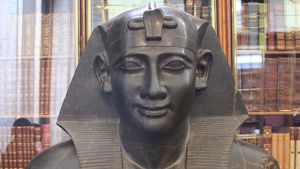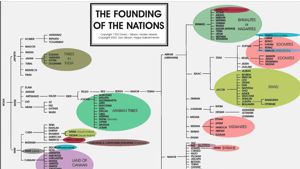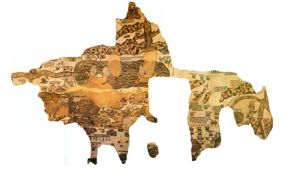The Economics of the Nabataean Empire
It has been accepted by historians that the Nabataean Kingdom was built on the basis of trade and economics, rather than a central political structure and the strength of a large army. Throughout the history of their empire, the Nabataeans engaged in trade, purchasing goods in Southern Arabia, India, and East Asia, transporting them by boat and camel caravan to the inner Nabataean Kingdom from where they transported and sold these goods to the Egyptians, Greeks, and Romans.
The Nabataeans did not transport one type of product, but rather, they transported a large variety of goods, including incenses, spices, precious stones and rare plants and animals. In the Middle East the Nabataeans gained control of the bitumen trade and the copper trade, where they managed the mining and marketing of these products. In the incense business, however, they purchased their products from the southern Arabians. This allowed the kingdoms of Southern Arabia access to European gold, and consequently they were able to build significant civilizations in what are now the countries of Yemen and Oman. Arab and Nabataean traders also purchased goods from India and China, and, as a result, aided these nations in building significant civilizations as well.
The Nabataeans used a number of devices to help them monopolize their trading. On the Red Sea, their pirates all but stopped the Egyptians from sailing to Arabia and India. On the Mediterranean, their pirates robbed back the goods that they had sold to the Egyptians, who in turn were transporting and selling them to the Romans, thus allowing them to reap a double profit.
The Nabataeans also invented stories of how difficult and nearly impossible it was to obtain their products. These stories, including those of winged serpents, helped keep their customers happy with the high prices that the Nabataeans were charging.
Finances
In order to be successful at being middlemen, the Nabataeans had to control both ends of the trade business. They had to successfully manage the buying process, keeping their suppliers happy with the pittance that they paid for their goods. On the other end, the Nabataeans had to carefully control their selling price, getting whatever the market could bear.
Fortunately for the Nabataeans, incense was deemed a necessity in the Egyptian, Greek, Babylonian, and Roman worlds. It was needed for religious events, and religion controlled much of man’s life at that time. Thousands upon thousands of temples and altars dotted the landscape and each one of them was a customer for Nabataean frankincense. Every wealthy home had its own private altars and each of these also required frankincense. Added to this, it was becoming increasingly popular to burn frankincense at Roman cremations. The Nabataeans were into a good thing.
Certain events, like those of a major war or the death of a high state official could put tremendous demand on the supply of incense products. When Roman generals went to war, they often offered sacrifices to their gods in order to obtain their favor. As time passed, these generals offered larger and larger amounts of incense, sometimes on multiple altars in multiple temples, just to give them the edge in battle. The cost of these offerings was astounding, and the empire had to incur the cost.
Added to this, Roman households were becoming used to Asian spices, cloth and other goods. Herodotus, the historian, complained bitterly about Rome’s trade deficit (100 million sesterces). He added, “So expensive are our luxuries and our women!” The Nabataeans, ever good businessmen, told the Romans about the high cost of purchasing and importing goods, and continued to invent stories about the great wealth that the foreign nations were gaining.
Agatharchides of Kindos, an Alexandrian scholar of the 2nd century BC, recorded some of what people were saying at the time.
“No people appear to be wealthier than the Sabeans and Gerrheans (in NE Arabia and in the Arab Gulf), for they have piled up in their treasuries all the riches that they have gained from Europe and Asia. They are the ones that have made Ptolemy’s Syria rich. It is they who have, amongst many other things, made it possible for the Phoenicians to make lucrative deals. Their luxury is not only displayed in marvelous embossed and engraved metal work and in the variety of their drinking vessels but in their beds and tripods, which are also unusually large. This luxury reaches its climax in the many house-hold objects which are known to us well. Many of these people own royal riches. It is said that they have numerous gold and silver columns, and the doors of their houses are decked with ornaments and jewels. Even the walls between the columns are said to be magnificently decorated.“
And so, fables of fabulously wealthy cities in the deserts of Arabia started to spread. Ubar, Saba, and other places were rumored as being wealthy beyond measure. As a result of stories like these, the Romans looked upon the riches of southern Arabia with envy. Little did they realize that the kingdoms in southern Arabia were only profiting a little from the trade, and that the bulk of the price of these goods was being skimmed off by Nabataean merchants. These merchants lived modestly, many of them in tents or aboard ship. It was hard to imagine that they were making a killing on their products.
Today archeologists are uncovering the civilizations of Yemen and Oman. Amazingly enough, archaeologists have not discovered wonderful riches and fabulous treasure. Instead, these cities were regular trade centers, using the income from frankincense to build walls and obtain armaments, so that they could wage war against their neighbors. The incense trade kept them supplied with a regular income, but it was nothing like what the Romans imagined.
When the Romans realized how desperate their financial situation was getting, they launched an ill-fated attempt to reach the frankincense fields of Southern Yemen. This clearly demonstrates the financial importance that frankincense and the Nabataeans had on the Roman Empire.
As I demonstrate in other pages, the Nabataeans did not limit themselves to trading in incense, but they expanded their trade goods to include all of the luxury items that the Romans desired. Their trade ventures took them farther and farther afield, until they were regularly visiting the coasts of Africa, Arabia, India, Ceylon, and eventually Indonesia and China.
Coins
It is possible to trace some of the economic ups and downs of the Nabataean Empire by studying the mineral content of Nabataean coins. This will help us chart economic events in Nabataean history.
Around 60 BC the Nabataeans introduced their first coins. As with all new coinage, they had to establish the value of their currency, so they started with a silver content of around 97%. This made their coins of equal or greater value to those issued by Rome. They kept up this relatively high level of silver until 29 BC when the Romans dropped the silver content of their coins. The Nabataeans followed suit and dropped the percentage of silver in their coins to 62-75 % to match the Romans.
Then in 7 AD the Nabataean economy took a turn for the worse and the level of silver dropped drastically to 54 % and then sunk to the low of 20 percent in 50 AD. It remained at this level until 72 AD when it rose to 42.5 percent and stayed at this level until 78 AD. In 80 AD it dropped to the low of 20 percent and did not rise again. The Nabataeans stopped minting in 100 AD.
There is not a more sensitive instrument for evaluating an economic and political situation than the state of the currency, whether in ancient or in modern times. The high level of silver in Nabataean currency in the early years may be explained by their attempt to prove themselves an equal with the other civilized nations. In time however, the cost of creating an empire, and erecting cities such as Petra and Bostra created significant financial strains on the Nabataean Empire, and the level of silver in their currency dropped dramatically.
Aelius Gallus’s campaign against the Southern Arabians in 24-25 BC had little effect on the Nabataean economy except for a 10% drop in the silver content.
As already mentioned, the big drop came in 7 AD. This may have been the topic of Strabo’s statement about the change in fortunes of the Nabataean spice trade. (Geography XVI.2.24) Some have speculated that it must have been during this year that Roman boats began to make direct voyages to India, breaking the Nabataean monopoly on luxury eastern goods.
Some archeologists believe that the low economic period from 50 - 73 AD corresponds with the Nabataean’s possible loss of control of part of the Negev, and some of their cities and routes to the Mediterranean. During this time, their markets began to shift from Damascus to the city of Palmyra.
The currency revived again under King Rabbel’s emphasis on agriculture and dam construction, but the kingdom failed to revive, and it eventually gave into pressure to become a part of the Roman Empire.
Internal and External Revenue
A detailed study of any nation’s economics could fill volumes. Needless to say, there are several simple rules of economics that have governed nations since the beginning. Fundamentally, a nation’s economic strength can come from two sources… outside or inside. By carefully studying these sources, one can determine the strength of the nation’s economy.
External Revenue
In the ancient world there were two ways to stimulate a nation’s economy from the outside. The first was military conquest. Many ancient rulers used this basic rule of thumb. Attack the enemy and take his resources, or make him pay tribute. And so, great civilizations swept back and forth across the pages of history. As they expanded, their economy grew, flush with gold and silver taken from the nations they conquered. If these nations resisted takeover, then their people were turned into slaves. If they agreed to the takeover, then they paid dearly for their freedom and often their young men ended up serving in the conqueror’s army. Either way, the civilizations that conquered their neighbors grew rich and powerful.
The second source of external revenue was that of trade. If you had something to sell, or if you could purchase goods cheaply from a neighbor on one side of your civilization, and sell it to a neighbor on the other side of your civilization, you could profit handsomely. If you managed to gain a monopoly on a certain item, you could raise the price of your goods to whatever your neighbor could pay.
The easiest form of this was mining. Ore could simply be extracted from the ground and sold abroad for easy cash, or manufactured into goods that could be sold. Another easy form of this was exporting agricultural products such as grain or sheep and cattle.
While trade sounds great to us, it was fraught with all sorts of dangers. First, thieves and pirates would attempt to steal your goods while enroute. Secondly, you customer might find out where your source was, and exclude you as the middleman or find a cheaper source of goods. Third, if you pushed the price too high, your customer might attack you and simply take the goods. Fourth, you might start using the goods yourself, and end up only importing and not exporting, thus ruining your trade business.
Internal Revenue
This kind of revenue was usually produced from mining or growing materials for export, and also from manufacturing good that other nations wanted. Below is a list of some of the goods that they were involved in.
| Bitumen | sole production and trade with Egypt |
| Horses | horse raising, marketing to nations around, mostly for use in racing |
| Sheep | vast herds, sold as food to surround nations, or used for wool |
| Pottery | unique, high quality, used in worship or personal homes |
| Mining | copper produced in Wadi Araba |
| Trade Goods | Trade from Arabia, Africa, India and China in incense and luxury goods |
Early trade routes
Because of their ability to harvest water in the desert, the Nabataeans developed their own trade routes, independent of the traditional water sources that were under the control of local tribes.
Many of the goods they produced were sold to Egypt, Greece and Rome for exorbitant prices.
In a few cases they managed to act as pirates on the trade routes of these empires, and thus stole back the goods they sold, and then managed to sell them back again.
It can be demonstrated that the Nabataeans gained control over the maritime trade route to the east. Thus, they were able to bypass the Silk Road and the high taxes levied on it. Because of this they were able to deliver eastern luxury goods to the Mediterranean markets at much lower costs to themselves, allowing them to pocket the difference as additional profit.
Additionally, once the Nabataeans had control of Palmyra at the western end of the Silk Road much of the trade between the east and Rome passed through their territory allowing them to influence the availability and price of luxury goods throughout the Roman Empire.
By 85 BC the Nabataeans had reached their economic pinnacle. They started massive building programs, and lavish spending. Their economy experienced a gradual decline as they spent much of their wealth on things that flaunted their importance. This decline can be demonstrated by the silver content in their coins.
Effects on the Roman Empire
During the time of the Roman Empire, the Romans began to experience economic problems. The women of the empire desired luxury goods, but the costs were often exorbitant.
The Oppian Law was passed following the defeat of the Roman Army by Hannibal at the battle of Cannae (216 BC). Because of the wars with Carthage, many men had died. Their wives and daughters had inherited their lands and monies, allowing many women to become rich. In order to help pay for the cost of the wars, the Roman government decided to tap into the women’s wealth by passing the Oppian Law. It limited the amount of gold women could possess and required that all the funds of wards, single women, and widows be deposited with the state. Women also were forbidden to wear dresses with purple trim (the color of mourning and a grim reminder of Rome’s losses). Nor could they ride in carriages within Rome or in towns near Rome.
Roman women obeyed this law with little fuss. Yet, at the end of the successful Second Punic War in 201 BC, male Romans and women in towns beyond Rome again donned their rich clothing and rode about in carriages. Women in Rome, however, continued to be denied these luxuries because of the Oppian Law. With the end of the wars, upper class women chaffed at these continuing restrictions and wished to keep their inherited money for their own use.
In 195 BC some members of the Tribunal proposed eliminating the Oppian Law. Women throughout Rome kept an eye on these proceedings. When it seemed that the majority of the Tribunal was about to veto the proposed repeal, these women poured into the streets in protest. It was the first time a women’s protest had been seen in Rome. As a result of the women’s protest, the tribunes withdrew their veto and approved the repeal.
Livy, a Roman historian, described the women’s demonstrations and a portion of the debate between Consul Cato and Tribune Lucius Valerius in the Tribunal.
“The matrons whom neither counsel nor shame nor their husbands’ orders could keep at home, blockaded every street in the city and every entrance to the Forum. As the men came down to the Forum, the matrons besought them to let them, too, have back the luxuries they had enjoyed before, giving as their reason that the republic was thriving and that everyone’s private wealth was increasing with every day. This crowd of women was growing daily, for now they were even gathering from the towns and villages. Before long they dared go up and solicit consuls, praetors, and other magistrates.
When the speeches for and against the law had been made, a considerably larger crowd of women poured forth in public the next day; as a single body they besieged the doors of the tribunes, who were vetoing their colleagues’ motion, and they did not stop until the tribunes took back their veto. After that there was no doubt that all the tribes would repeal the law.“
So, in 195 BC, the Oppia Law was revoked, and Roman women became free to flaunt their wealth in public. This is an important date for us, when considering Nabataean economics, because from this point on, the demand for Eastern luxury goods in Rome began to grow at an amazing rate.
Hortensia’s Speech to the Forum
Over a hundred years later, in 42 BC, war again preoccupied the Romans. This time it was civil war, and the ruling triumvirs were badly in need of monies. To raise funds they voted to tax 1,400 of the richest women in the state. Fearing that taxes collected from them might be used in battles against their own families, the women mounted a protest. They chose Hortensia, the educated daughter of the famous orator Quintus Hortensius, to speak on their behalf. Rudely forcing their way into the forum, the women pushed Hortensia toward the triumvirs’ tribunal. No female had ever spoken here before.
A second century historian, Appian, in later years recorded what he understood to be Hortensia’s speech:
_“You have already deprived us of our fathers, our sons, our husbands, and our brothers on the pretext that they wronged you. But if, in addition, you take away our property, you will reduce us to a condition unsuitable to our birth, our way of life, and our female nature. _
If we have done you any wrong, as you claimed our husbands have, punish us as you do them. But if we women have not voted any of you public enemies, nor torn down your house, nor destroyed your army, nor led another against you, nor prevented you from obtaining offices and honors, why do we share in the punishments when we did not participate in the crimes?
_Why should we pay taxes when we do not share in the offices, honors, military commands, nor, in short, the government, for which you fight between yourselves with such harmful results? You say ‘because it is wartime.’ When has there not been war? … _
_… Our mothers did once rise superior to their sex and made contributions when you faced the loss of the empire and the city itself through the conflict with the Carthaginians. But they funded their contributions voluntarily from their jewelry not from their landed property, their fields, their dowries, or their houses, without which it is impossible for free women to live… _
Let war with the Celts or Parthians come, we will not be inferior to our mothers when it is a question of common safety. But for civil wars, may we never contribute nor aid you against each other.”
Furious at the women’s demands, the triumvirs tried to drive them away. But the crowd yelled their support for the women and the following day the triumvirs reduced the number of women subject to taxation to four hundred.
One may consider whether the women availed themselves of the opportunity to flaunt any new-found wealth in the vulgar manner characteristic of Romans.
As Plutarch remarks, “Most people think themselves deprived of wealth if they are prevented from showing off; the display is made in the superfluities, not the essentials of life.” Women were certainly prone to this vice.
In the speech that Livy represents as winning the repeal of the Oppian Law, the argument was made that women, even without the control of the Oppian Law, would not take advantage of the freedom they could enjoy, “for they abhor the freedom that loss of husbands and fathers provides.” The speaker also points out that even Roman men would be dismayed if they were not permitted to flaunt their wealth in the face of their Latin neighbors. Naturally, women, who become disturbed over the merest trifles, would be all the more upset over their lost opportunities.
The Roman obsession with flaunting their wealth was used by the Nabataeans to cater to the Roman desires. Most Romans were at the mercy of the merchants to provide them with the latest luxury goods. I’m sure the Nabatraean merchants who lived in Puteoli on the Italian coast were doing whatever they could to supply the Romans with goods, and relieve them of their gold.
It is no wonder that Herodotus, the historian, complained bitterly about Rome’s trade deficit (100 million sesterces) when he said, “So expensive are our luxuries and our women!“
Suggested Reading
Astin, A. E., Cato the Censor, Oxford 1978, 25-27
Bauman, Richard A. , Women and Politics in Ancient Rome, Routledge, 1992
Bingham, Marjorie and Gross, Susan, Women in Ancient Greece and Rome, Glenhurst Press, 1983
Blasdon, J.P.V.D. _Roman Women: Their History and Habit_s, Harper & Row, 1962
Briscoe, J., A Commentary on Livy Books XXXIV-XXXVII, Oxford 1981, 39-63
Culham, P. The Lex Oppia, Latomus 41, 1982, 786-793
Evans, John K., War, Women and Children in Ancient Rome, Routledge, 1991
Fant, B., eds. Women’s Life in Greece & Rome, Johns Hopkins Press, 1982
Gardner, Jane, Women in Roman Law and Society, Indiana University Press, 1986
Internet Article: http://www.womeninworldhistory.com/lesson10.html Female Fury In The Forum Ancient Rome, 195 & 42 BC
Internet Article: About.com : http://www.stetson.edu/~psteeves/classes/pomeroy.html
Internet Article: About.com : http://www.uky.edu/ArtsSciences/Classics/wlgr/wlgr-publiclife173.html
Johnson, P.A., Poenulus I,2 and Roman Women, TAPA 110, 1980 143-160
Lefkowitz, Mary R. and Maureen, B. Frant, eds. Women’s Life in Greece & Rome, Johns Hopkins Press, 1982
Livy 34.2-7. Extensive discussion in Briscoe, Commentary, 39-42
Livy, History of Rome, Maureen Fant trans.
Millar, F., A Study of Cassius Dio, Oxford 1964, 78-83
Moscovich, MJ, Historical Compression in Cassius Dio’s Account of the Second Century B.C., Ancient World 8 (1983) 137-143
Pomeroy, Sarah B. Goddesses, Whores, Wives, and Slaves. Women in Classical Antiquity, Schocken Books, New York, 1975, 176-181
Rawson, Beryl, The Family in Ancient Rome, Cornell University Press, 1986
Scullard, H.H. Roman Politics 220-150 BC, Oxford 1973, 257




















Page Discussion
Membership is required to comment. Membership is free of charge and available to everyone over the age of 16. Just click SignUp, or make a comment below. You will need a user name and a password. The system will automatically send a code to your email address. It should arrive in a few minutes. Enter the code, and you are finished.
Members who post adverts or use inappropriate language or make disrespectful comments will have their membership removed and be barred from the site. By becoming a member you agree to our Terms of Use and our Privacy, Cookies & Ad Policies. Remember that we will never, under any circumstances, sell or give your email address or private information to anyone unless required by law. Please keep your comments on topic. Thanks!